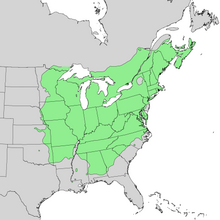Quercus rubra
| Quercus rubra | |
|---|---|
 |
|
| Autumn northern red oak specimen | |
| Scientific classification | |
| Kingdom: | Plantae |
| (unranked): | Angiosperms |
| (unranked): | Eudicots |
| (unranked): | Rosids |
| Order: | Fagales |
| Family: | Fagaceae |
| Genus: | Quercus |
| Section: | Lobatae |
| Species: | Q. rubra |
| Binomial name | |
|
Quercus rubra L. 1753 |
|
 |
|
| Synonyms | |
f.
787
all>
|
|
f.
787
all>
Quercus rubra, commonly called northern red oak, or champion oak, (syn. Quercus borealis), is an oak in the red oak group (Quercus section Lobatae). It is a native of North America, in the eastern and central United States and southeast and south-central Canada. It grows from the north end of the Great Lakes, east to Nova Scotia, south as far as Georgia, Alabama, and Louisiana, and west to Oklahoma, Kansas, Nebraska, and Minnesota. It has been introduced to small areas in Western Europe, where it can frequently be seen cultivated in gardens and parks. It prefers good soil that is slightly acidic. Often simply called red oak, northern red oak is so named to distinguish it from southern red oak (Q. falcata), also known as the Spanish oak. It is also the state tree of New Jersey and the provincial tree of Prince Edward Island.
In many forests, this deciduous tree grows straight and tall, to 28 m (92 ft), exceptionally to 43 m (141 ft) tall, with a trunk of up to 50–100 cm (20–39 in) diameter. Open-grown trees do not get as tall, but can develop a stouter trunk, up to 2 m (6.6 ft) in diameter. It has stout branches growing at right angles to the stem, forming a narrow round-topped head. It grows rapidly and is tolerant of many soils and varied situations, although it prefers the glacial drift and well-drained borders of streams. It is frequently a part of the canopy in an oak-heath forest, but generally not as important as some other oaks.
...
Wikipedia

